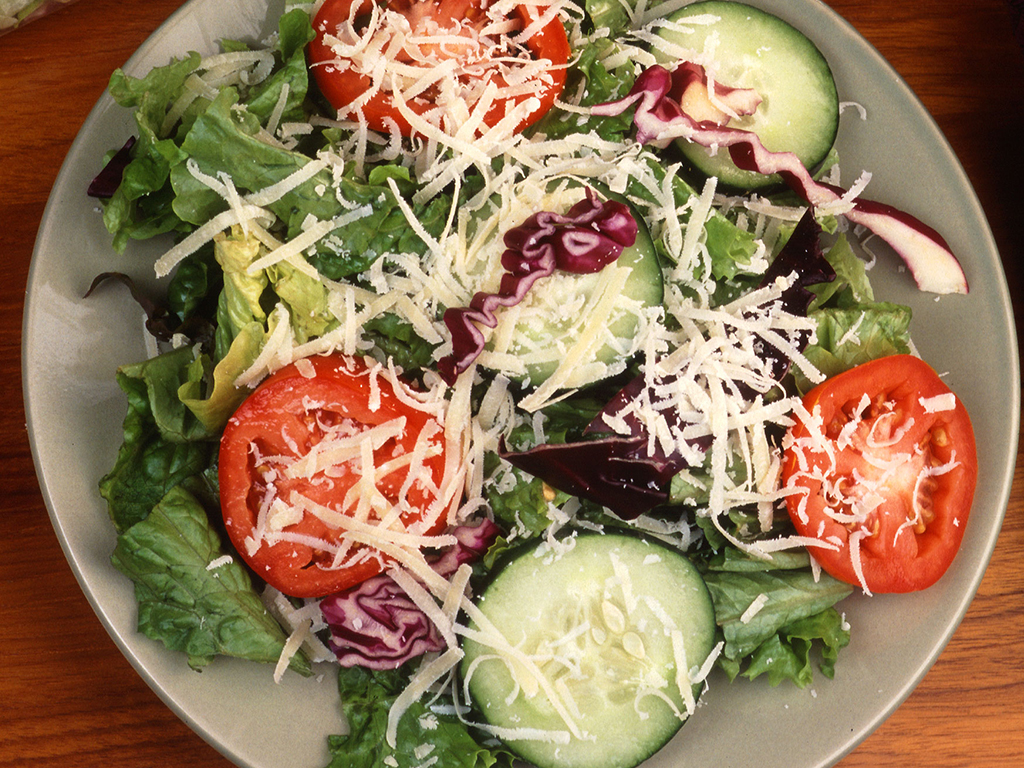
Photo by Keith Weller. Courtesy of USDA. | Download this photo.
Salads provide healthy, refreshing summertime meal
K-State nutritionist offers new ideas
Friday, May 31, 2017
MANHATTAN, Kan. — When some people hear the word “salad,” they think of a small bowl of leafy greens and creamy dressing that must be struggled through before the arrival of their steak or chicken.
While a salad often precedes the main course in restaurants, a salad can also serve as the main course – or the only course. Chefs, dietitians, even bloggers and “foodies” are taking on salads these days, and pushing them in new directions.
“I think we're seeing some new trends and ideas out there that really are widening our view of what a salad is, and what the components of it might be,” said Sandy Procter, K-State Research and Extension nutrition specialist.
For many, the base of a salad continues to be vegetables, usually one of the many varieties of lettuce. Add other vegetables, maybe some protein, and a dressing and you have a basic salad. Procter says this is a great way to add vegetables and fruits to your diet. “Even those of us that already make an emphasis on that probably aren't going to suffer if we have a few more,” she said.
Procter said there are four healthy reasons for adding more salads to our nutrition plan:
Fiber — “Most of us don't get enough fiber in our diet, and it works together with exercise to keep our digestive systems healthy and prevent some of the common chronic diseases of the day, including cancer,” Procter said.
Phytonutrients — These natural, plant-derived chemicals aren’t as critical as vitamins and minerals (also found in plants), but things like carotenoids and flavonoids help make us resistant to diseases and can slow down the aging process.
“Volumetrics” — If you’re one of those people that could stand to shed a few pounds, a properly designed salad can help you do this. The concept of volumetrics is that by eating larger portions of healthy foods, you’ll feel more satisfied. As an example, two apples have roughly the same number of calories as one candy bar, but the apples have more fiber and are bigger, therefore helping you feel fuller.
Great source of “smart fats” — We often think of “fat” as something that should be avoided in our diets, but not all fats are equal. Plant-based fats such as olive oil, nuts and seeds are good fats, and it’s not uncommon to find them in a salad. “So many of the salads we see featured now in restaurants have the option of adding avocado,” said Procter. “Avocado has a really nice sense of satiety because it’s kind of creamy, but yet it's not like sour cream which is a saturated fat — avocado has this healthy plant-based fat that can really add a lot of nutrition to your diet.”
When a salad becomes a main course, protein frequently becomes part of the lineup. Procter said while chicken and steak are popular options, protein doesn’t have to be limited to meat. Eggs, cheeses, nuts and seeds can deliver protein to a salad. Quinoa (“KEEN-wah”) is a protein rich grain that can be served warm or chilled, after it’s been cooked.
“Quinoa is very high in protein and can add a lot to a salad,” she said. “It's kind of crunchy and adds an interesting flavor. It brings a lot of protein to the plate as well.”
The biggest obstacle to taking a salad to work for lunch is keeping it cold. This can be accomplished by packing your salad with a frozen bottle of water or a reusable “chill pack” from your freezer. Procter says one of the newest trends in brown-bagging salad is an old standby from your grandmother’s kitchen: the Mason jar or canning jar.
“The beauty of the Mason jar salad is that dressing goes in the bottom, followed by whatever ingredients you choose — you can see each layer and portion them out. Add the leafy greens last, screw on the lid, and then it's easy to transport. The glass can stay cold longer than plastic. Give it a good shake when it’s time to eat,” she said.
“Also, the glass doesn't absorb flavors as many plastics do, so you can carry balsamic vinegar one day and blue cheese the next, and those flavors aren't going to be blended. Glass is easy to wash up and use the next day.”
Whether for a school lunch or a meal at home, a salad provides younger family members an opportunity to assemble their favorites. “Research has proven that vegetables and fruits are well received when a child has a chance to choose their favorites, to go through something like a salad bar and make those selections themselves.”
Salads also provide an impetus for frequenting local farmers markets to take advantage of locally grown produce. “Seasonal vegetables can be found at a really good price, and they’re really fresh,” said Procter. “And try to take the kids with you, let them pick some things out. That's a great way to get kids interested in adding vegetables and fruits to meals, by letting them think that they got away with something.”
“Salads are really nice way to widen people's thoughts about what vegetables can be,” concluded Procter. “Not necessarily cooked and hot all the time — those cold, crisp bite-sized vegetables can be really welcoming on a warm summer’s day.”

